Table of Contents
Top Jain Temples in Khajuraho, Madhya Pradesh, India
At the Jain temples of Khajuraho, part of the UNESCO World Heritage Site, we were awed by the exquisite sculptures and lost in thought. Have you ever wondered how the wonderful works of art of the world evolved? How a child who can barely wield a pencil goes on to create masterpieces on canvas? How a boy becomes a Michael Angelo or one of the innumerable unnamed sculptors of India who have shaped some of the rarest and the best of carvings and sculpture the world has ever seen or will see.
The journey of the artistic expression of man is fascinating and Madhya Pradesh in the heart of India seems to encompass the entire school of human artistic thought and execution.
In the kindergarten section of the Bhimbetka Rock Caves, some 100,000 years ago Man left the imprint of what is recognized as his first artistic expression in the form of simple petroglyphs. He slowly graduated to childlike line drawings that represented whatever he saw around him. One day he must have discovered that he could also shape rocks by chiseling away portions.
His drawing proclivities must have slowly evolved into stone sculptures and carvings and by this time his life had gone much beyond the thought of satisfying basic needs and encompassed religion, philosophy, and spirituality. This can be seen in the rock sculptures of the Udayagiri Caves and the exquisite gates of Sanchi. His skill with stone reached its crescendo when he breathed life into stone and carved the exquisite Khajuraho sculptures.
Yes. Khajuraho in many ways is the culmination of the artistic journey that started in the dark recesses of the Bhimbetka caves, and as if it were pre0rdained our journey with the Times Passion Trails and Madhya Pradesh Tourism too culminated at Khajuraho. The UNESCO World Heritage Site of the Khajuraho Group of Monuments is a visual feast, a celebration of the artistic mastery of man over a stone and this can be seen in all the temples including the Jain Temples of Khajuraho, which is the focus of this Khajuraho blog post.
Jain Temples of Khajuraho – Songs In Sandstone
If you thought Khajuraho is all about erotic sculptures depicting different Kamasutra positions then you are absolutely wrong! Yes, there are erotic sculptures, but they are only a small percentage of the exquisite sculptures and carvings that make up the temples at Khajuraho. The Jain temples of Khajuraho are a glowing example of the architectural and design finesse that pervades the Khajuraho monuments.
The Emergence of The Khajuraho Group Of Monuments
The Jain Temples at Khajuraho are part of the Khajuraho group of monuments and hence to understand them, their design, and genesis, it is but fitting to delve a little into the realms of Khajuraho temple history. Most of the Khajuraho temples were built within the span of a century, between the end of the 10th century and the beginning of the 11th century. The temples sprouted with remarkable prolificity during this time under the rule of the Chandela Kings.
The Chandelas who traced their ancestry to the Moon and were part of the Lunar dynasty or Chandravanshis who ruled over the Bundelkhand region of Central India, then known as Jejakabhukti. The Chandelas reigned between the 10th and 13th centuries and had their capital at Mahoba.
The Chandelas were connoisseurs of art and architecture and their reign saw the mushrooming of many temples, forts, palaces, and other structures. In many ways, they can be compared to the great kings of the Khmer Empire in Cambodia like Suryavarman II and Jayavarman VII during whose reign the great temples of Siem Reap like Angkor Wat, Bayon Temple, Ta Prohm, and others rose to the skies. It is interesting to note that the temples of Khajuraho and some of the majestic temples of Siem Reap must have been built around the same time.
It is now known that by the 12th century there were around 85 temples in the region which was known as Kalinjar near present-day Khajuraho. However, the Chandela dynasty declined in the 13th century and the temples of Khajuraho too fell on bad days. Many of them were destroyed by invaders from the Delhi Sultanate and others slowly were swallowed by the jungles. It was only in the early part of the 19th century, that the temples were rediscovered.
Today what remains of the legacy of the Chandela dynasty is around 25 temples that stun the world with their sheer beauty.
Important Temples of Khajuraho
The temples of Khajuraho have been classified as Eastern Group of Temples, Western Group of Temples, and the Southern Group of temples.
Some of the top temples of Khajuraho are listed below:
- Kandariya Mahadev Temple
- Lakshmana Temple
- Adinath Temple
- Parshvanath Temple
- Chaturbhuj Temple
- Matangeshwara Temple
- Chitragupta Temple
- Chausath Yogini Temple
- Dulhadeo Temple
- Javari Temple
- Vamana Temple
- Ghantai Temple
- Shantinath Temple
- Devi Jagadamba Temple
- Varaha Temple
- Vishvanath Temple
Visiting The Jain Temples of Khajuraho
The Jain Temples of Khajuraho are enclosed within a contemporary enclosure and has about 16 different temples. The most important of these are the Adinath Temple and the Parshvanath Temple. Both these temples are the oldest too, dating back about a thousand years. During those times the eastern part of Khajuraho was inhabited by Jain merchants and hence the Jain temples are concentrated in this particular area. The secular character of the Chandela dynasty and the co-existence of Hinduism and Jainism in that period is amplified by the existence of the Jain temples of Khajuraho.
There are many later temples that have been built on older bases surrounding the Adinath and Parshvanath temples, but these two with their intricate carvings stand out.
The most important of the Jain Temples of Khajuraho are:
- Adinath Temple
- Parshvanath Temple
- Ghantai Temple
- Shantinath Temple
The Adinath Temple, Khajuraho
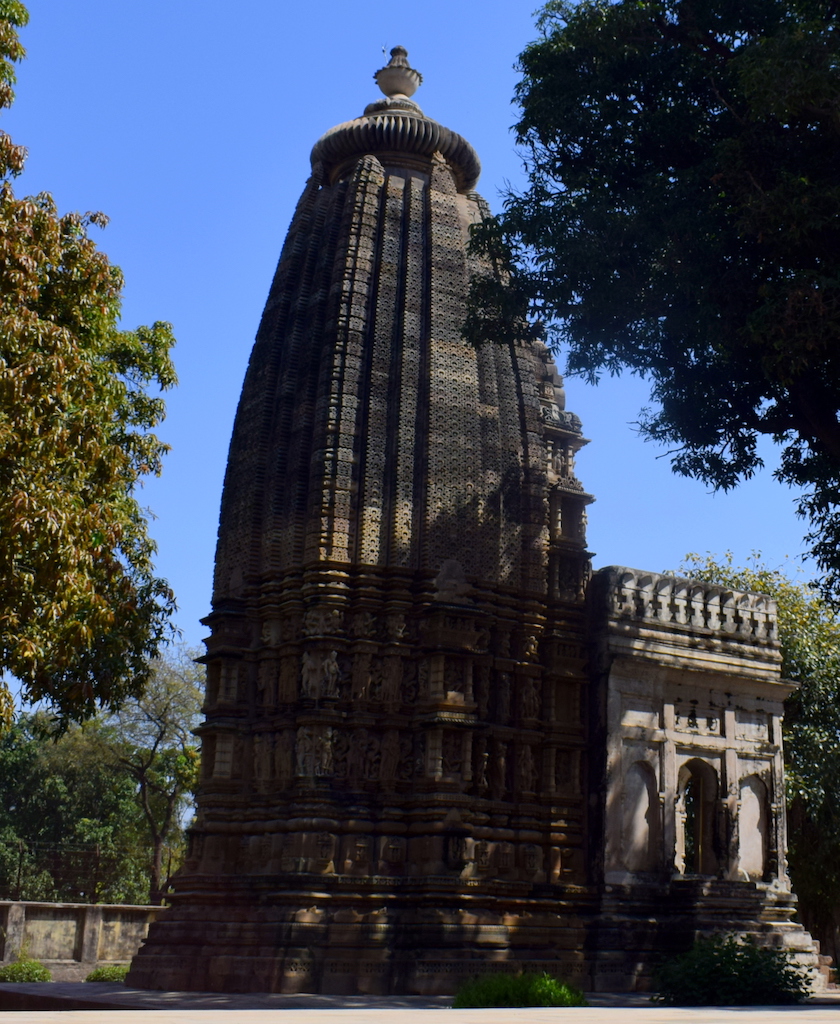
What strikes you first is the incongruity. The Shikhara of the Adinath temple rises to the skies in a spurt of grace with its outer walls embellished with stunning carvings. But what spoils the visual feast and sticks out like a sore thumb is the Adi Mandapa which is the outer porch that was built at a later date, this element with its white plastered walls stands out against the elegance of the Garba Griha (Sanctum Sanctorum) and Shikhara(Tower) that have survived from over a 1,000 years.
Inside the temple, there is a black idol of Adinatha also known as Rishabhanatha, the first Jain Tirthankara. However the idol itself is a later addition, and it is not known what was the idol that was in the sanctum sanctorum originally.
Architectural Design & Carvings At The Adinath Temple
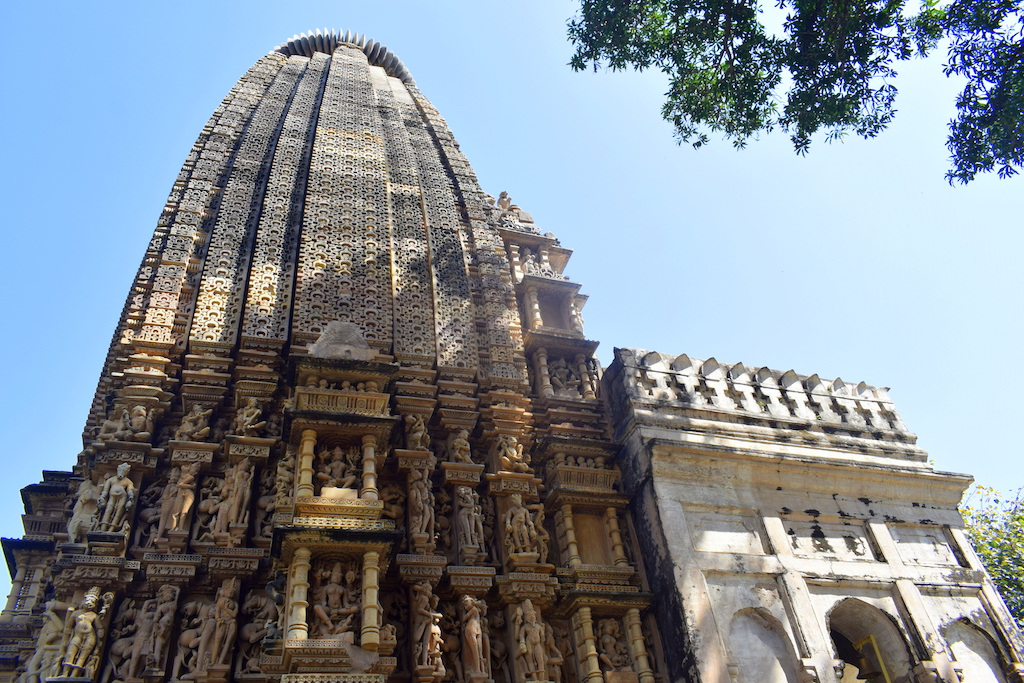
A board near the Adinath temple gives a brief description of what the original temple must have been like. It states that the original temple that was probably built around the 11th century had all the elements of the Nirandhara style of temple architecture, Nirandhara refers to temples without circumambulatory paths.
It also states that the original temple had a Mandapa and an Ardha Mandapa which were lost with the passage of time. The temple was conceived along the lines of a Saptaratha temple and was similar to the Vamana Temple in design, though more evolved in terms of the elaborate designs of the outer walls.

“The Adinath temple structure consists of three distinct parts, the Jagati, the Janga, and the Shikhara”, explained our guide – Anurag Shukla. He went on to give a detailed synopsis of the temple’s architecture and design.

The lower part of the temple is decorated with lotus petals, which symbolically places the entire temple itself on a lotus flower. In many ways the carvings on the outer walls also represent evolution. At the bottom is water which is believed to be the start of life and the lotus represents this stage followed by motifs of creepers and other vegetation at the next level. Above this are the symbolic representation of animals and this is shown by the mythical monster known as Kirtimukha. The Shikhara or the peak of the temple is decorated with Amalaka and Kalasha which are standard elements of Hindu temple architecture.
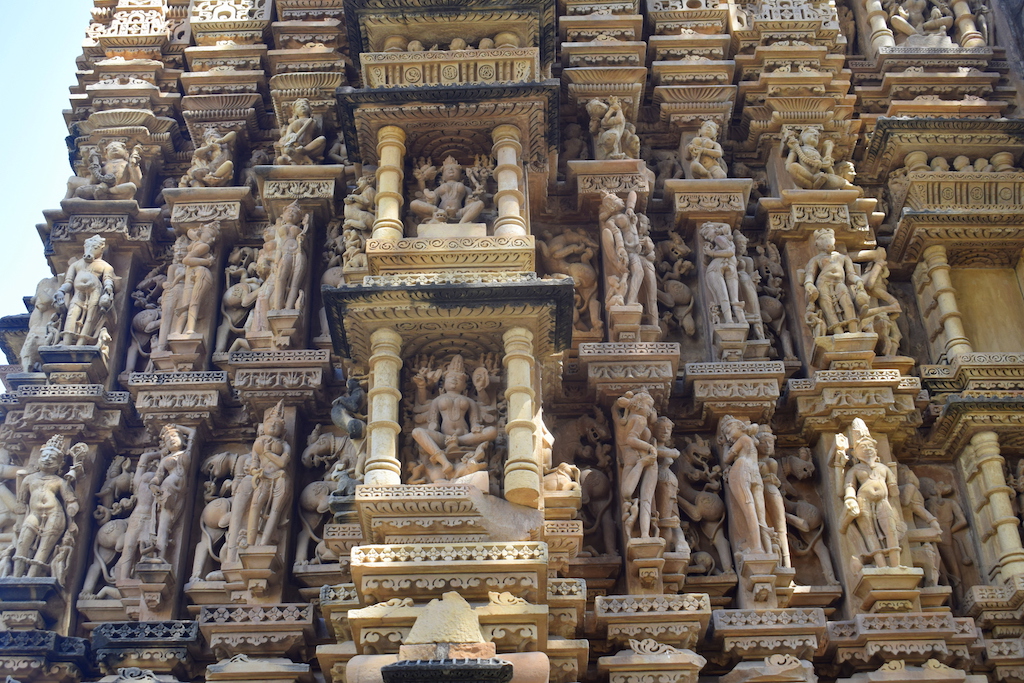
In many ways, the entire temple itself represents a Kalasha which is an important part of Hindu temple iconography. In traditional Hindu worship, the presence of the deity is invoked in the Kalasha which is then worshipped. Similarly, the deity dwells in the Garba Griha of the temple and is worshipped.

Beautiful carved iconography of Hindu temple architecture bedecks the outer walls of the Adinath temple, but the niches in the centre are occupied by lovely sculpted figures of Jain Godesses and others from Jain religious iconography, who are adapted from the Hindu Goddesses like Durga, Ganga, etc..
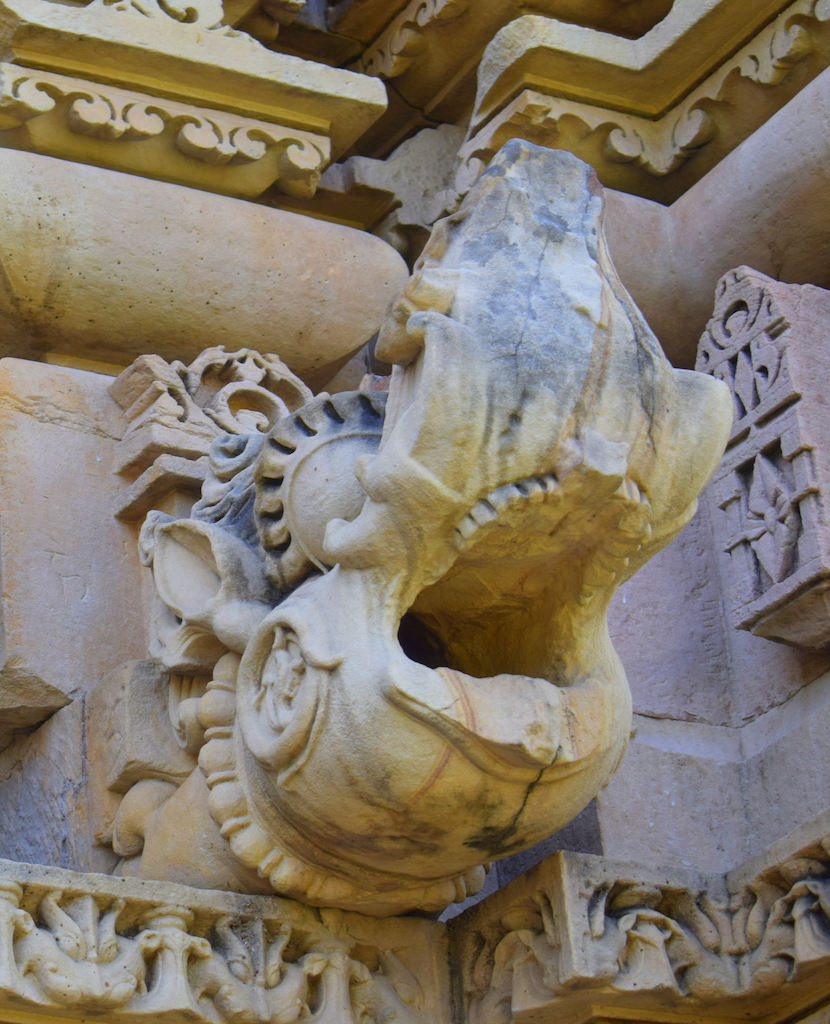
A Makara shaped Pranala at the Adinath temple is an interesting sight. Pranalas are the outlets for water and other liquids with which the deity is washed or anointed ritualistically during Abhishek. The Pranalas are characteristic elements of Hindu temple design and combine utility with aesthetics. They can be of different shapes like the head of a cow, a Makara, etc.. Here the Pranala is in the form of the head of a Makara, which is a mythical sea animal, usually associated as the vehicle of Goddess Ganga.
The Parshvanatha Temple, Khajuraho
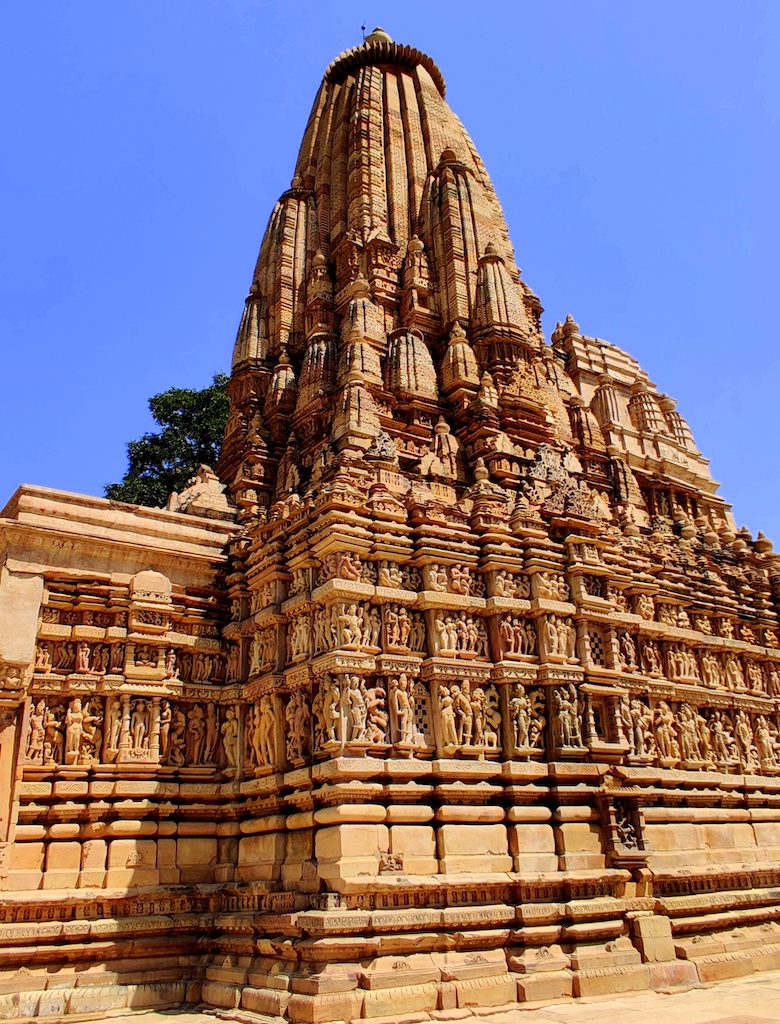
The Parsvanatha temple was actually built as a temple to Adinath, but the idol was broken and then replaced with an image of Parsvanatha and is today known as the Parshvanatha Temple.
The two temples of Adinath and Parsvanatha stand side by side and present a symphony of the best of Hindu architecture and iconography fused with Jain religious symbology. While the Adinath Temple has a single Shikhara, The Shikhara of the Parshvanatha Temple is bedecked with multiple Urushringas or small Shikharas.
The Urushringas are smaller towers as compared to the main tower and give the illusion of being embedded onto the main tower. They also serve to increase the perception of the height of the main Shikhara. This type of architectural style is known as Sekhari or Shekhari and is common among the Khajuraho group of monuments. Another example of Sekhari style can be found at the famous Kandariya Mahadeva Temple in Khajuraho.
Architectural Design & Carvings At The Parshvanatha Temple

The two temples of Adinath and Parsvanatha stand side by side and present a symphony of the best of Hindu architecture and iconography fused with Jain religious symbology. While the Adinath Temple has a single Shikhara, The Shikhara of the Parshvanatha Temple is bedecked with multiple Urushringas or small Shikharas.

The Urushringas are smaller towers as compared to the main tower and give the illusion of being embedded onto the main tower. They also serve to increase the perception of the height of the main Shikhara. This type of architectural style is known as Sekhari or Shekhari and is common among the Khajuraho group of monuments. Another example of Sekhari style can be found at the famous Kandariya Mahadeva Temple in Khajuraho.
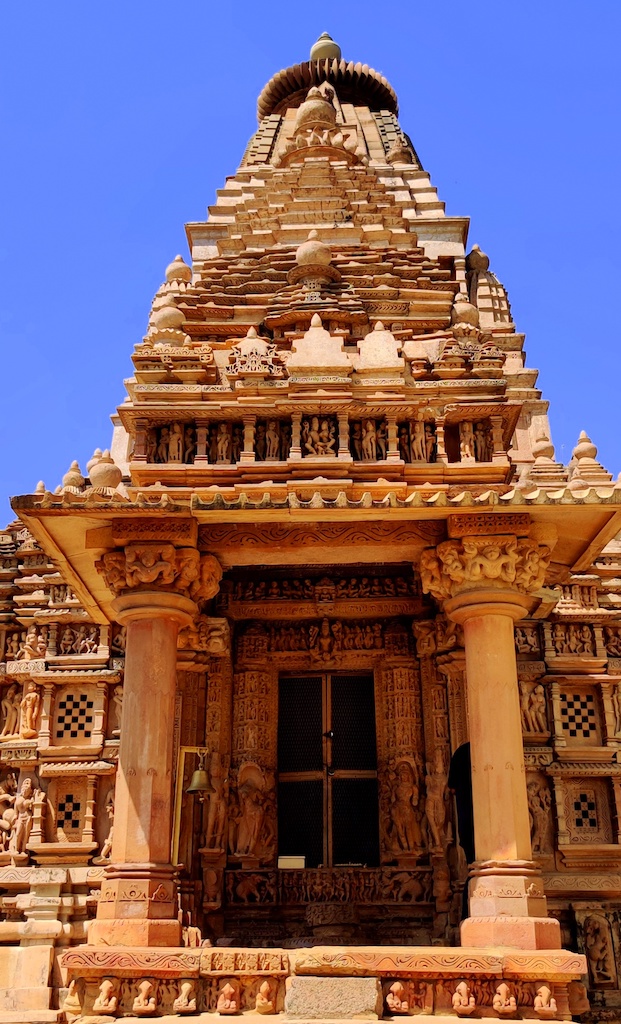
Another difference between the Adinath Temple and the Parshvanatha Temple is that while the former belongs to the Nirandhara style because of the absence of a circumambulatory passage or Pradakshina, the latter is categorized as Sandhara, though it does not have the usual balconies with windows that make up the passage that circumscribes the Garba Griha.
However, there are beautiful latticed windows instead. Also noteworthy is the extension of the shrine behind the Sanctum Sanctorum which is embellished with exquisite sculptures so typical of the Khajuraho group of monuments.
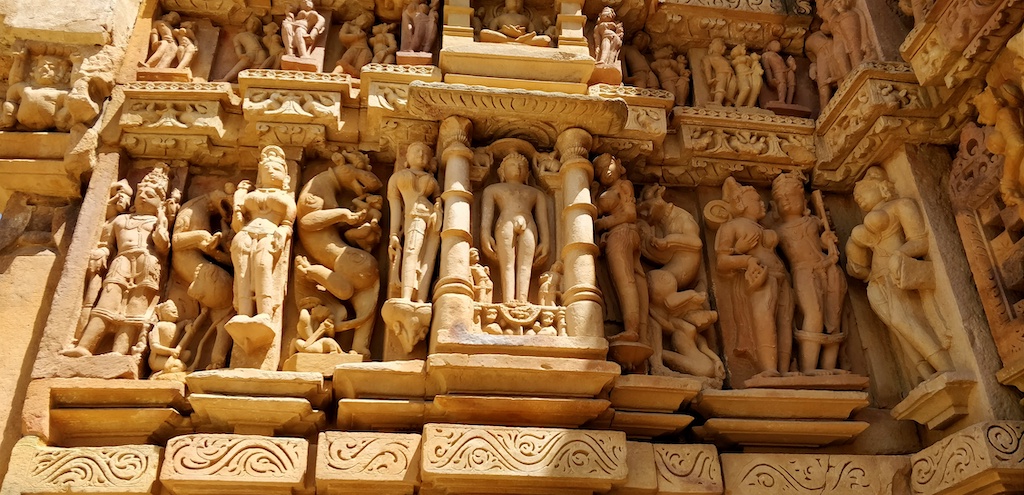
The beautiful temple of Parshvanatha is the oldest, best-preserved, and grandest of the Jain Temples of Khajuraho. It dates back to 954 AD One can spend hours with necks craned up admiring the finesse and artistic mastery of the unknown craftsmen who turned plain stone into characters that seem almost lifelike and human.
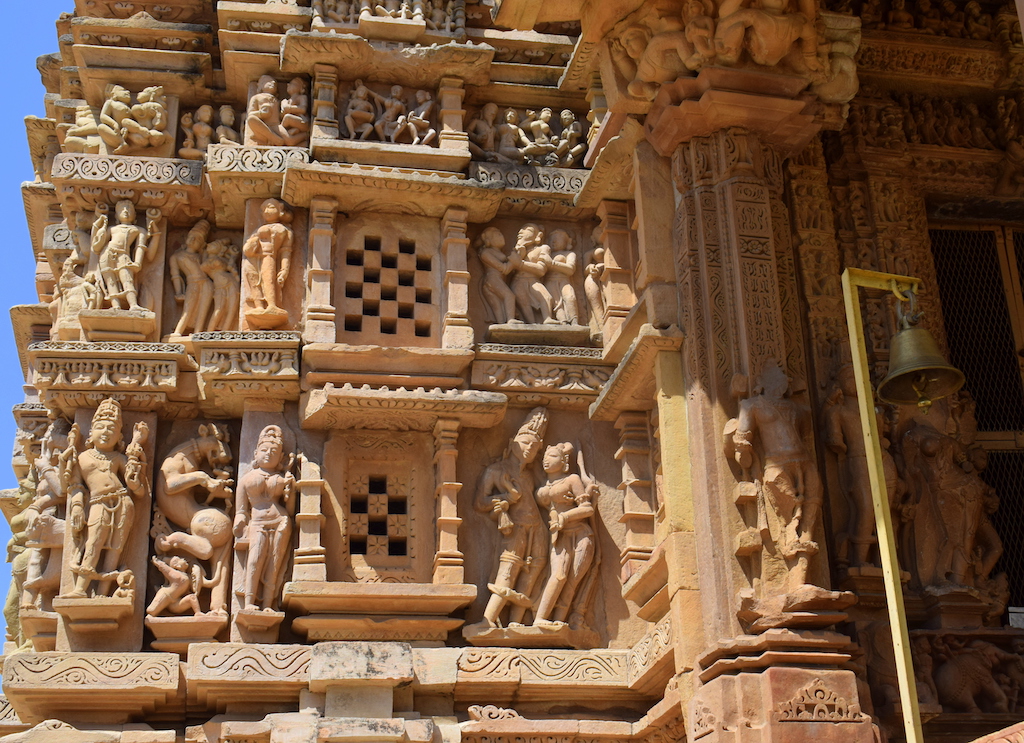
The outer walls are full of detailed and beautiful sculptures of Surasundaris or Apsaras, as well as Hindu Gods and Goddesses and characters from Hindu mythology. The sculptures of Vishnu and Lakshmi, Ram and Sita, Hanuman, Balaram and Revathi, and many others can be seen. Also seen are mythical animals and other celestial beings, musicians, and dancers. Let us take a look at some of the sculptures that had our attention riveted with their exquisite detailing.
The eloquence of the silent stones leaves one speechless as their songs in sandstone reverberate across the chasm of time
The figure of a beautiful dancer bedecked with jewelry, where the sculptor has even brought out the details of the folds of her garment.
A Surasundari getting ready, applies kohl to her eyes while her face has a demure expression and just the hint of a smile.
A woman wearing an anklet with the help of her maid, the difference in social status probably shown symbolically by the difference in scale of the two figures.
A woman who is apparently removing a thorn from her feet is depicted in great detail, from her balanced stance, as she stands on one foot, to the expression on her face. An expression that seems to convey pain mixed with relief.
It is apparent that the unknown sculptors who breathed life into these stone figures visualized something much beyond the physical. This becomes apparent especially when you see the sculptures of Ram with Sita, their love and oneness blossoms forth which probably is what the sculptor had set out to achieve.
A rare sculpture of Balaram, the brother of Krishna with his consort Revathi, note the sublime expressions on their faces that have been skilfully captured by the sculptor.
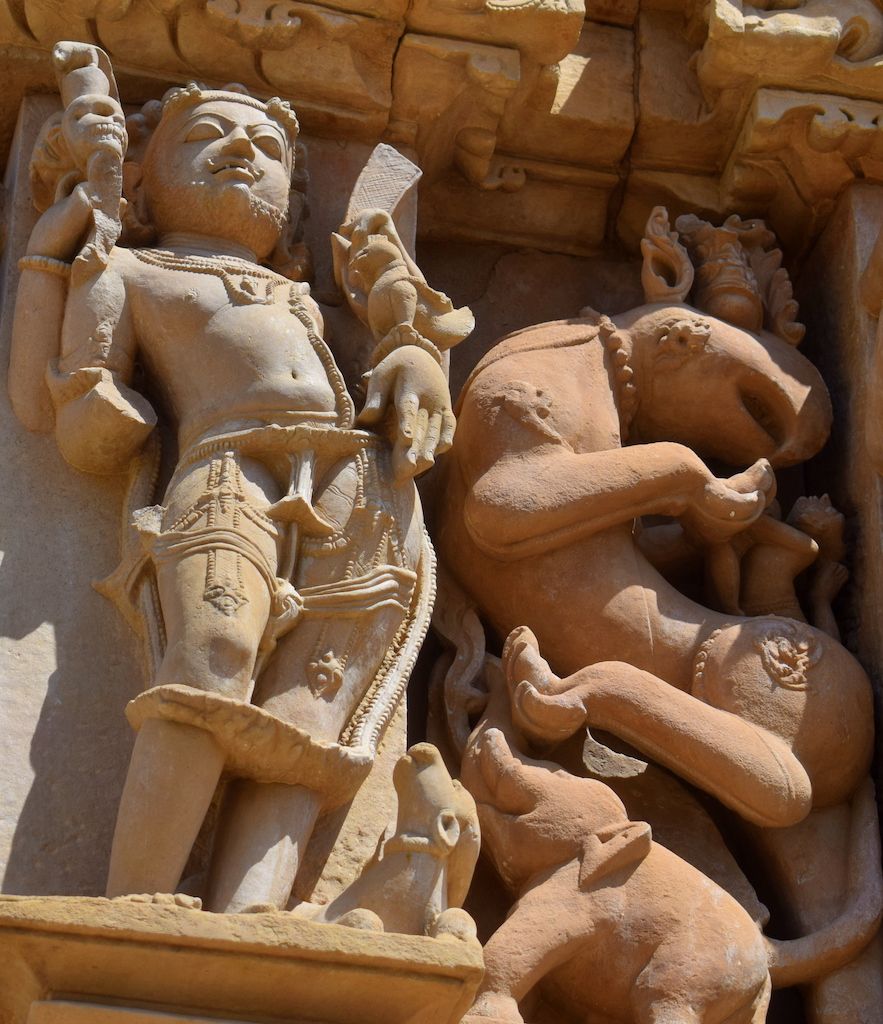
The Hindu God of death – Yama, is depicted in all his ferociousness, his mouth slightly open with a snarl, his teeth slightly visible. In short a countenance that evokes fear.
These Khajuraho temple images capture the grandeur and the aesthetically evolved craft that is so characteristic of the Khajuraho group of monuments.
The Shantinath Temple, Khajuraho
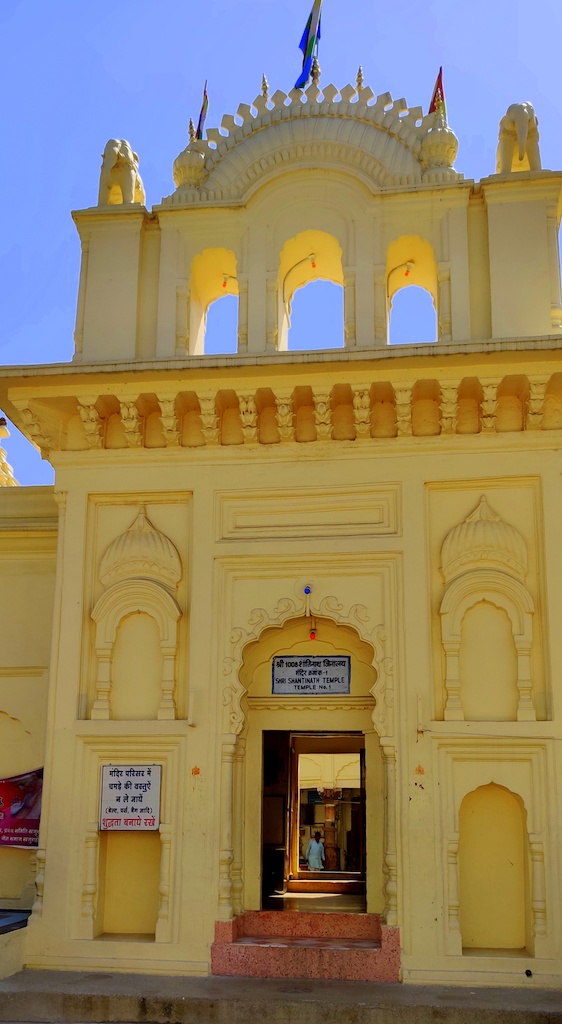
The Shantinath Temple is a 19th-century temple that is dedicated to the Jain Tirthankara Shantinatha. It houses many old temples enclosed within a modern-day quadrangular structure. This includes the 11th- century shrine of Shantinatha. There are statues of Bahubali as well as the parents of Mahavira within the temple premises.
The Ghantai Temple, Khajuraho
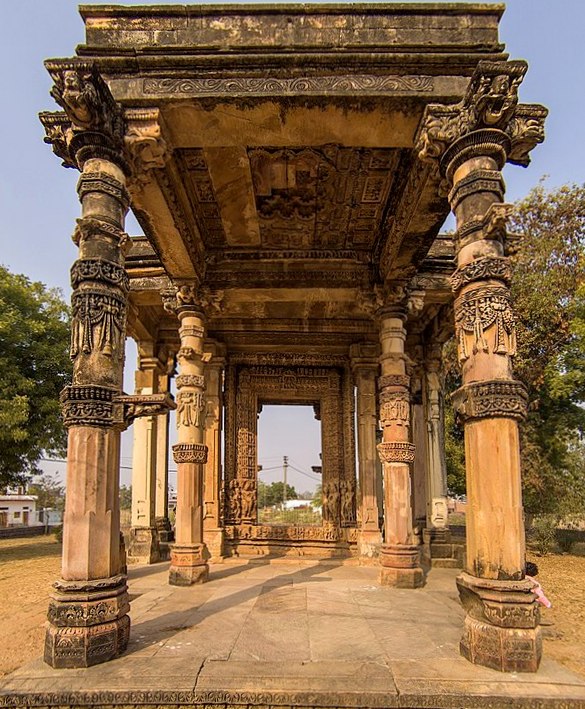
The Ghantai temple is a 10th-century temple dedicated to Adinatha which is in ruins today. The temple is not within the cluster of the Jain temples of Khajuraho. The temple is today reduced to pillars standing defiantly against the march of time. There are elaborately designed motifs of chains and bells on the pillars, because of which it gets its name.
Jain Temples of Khajuraho – Interesting Facts
- The more than 1,000 years old temples of Adinath, Parsvanatha, and others are still in use with the idols being ceremoniously worshipped
- The Jain temples architecture and design are similar to the temple architecture of the Hindu temples as there was no separate architectural style
- Jain temples sprang wherever the Jain monks sat and preached with the result that there are many small temples in and around the main temples of Adinath and Parshvanatha
- The Jain temples of Khajuraho too like the Jain temples elsewhere are all dedicated to different Jain Tirthankaras
What you should know before visiting the Khajuraho temples
- Khajuraho temples are open from 8 am to 6 pm on all days
- Best time to visit Khajuraho is between October to February when the weather is quite cool
- Khajuraho group of monuments consists of both Hindu and Jain temples
- Khajuraho temples are famous for their nagara-style architecture and erotic sculptures
- The Khajuraho group of temples were built by Chandelas
- The Khajuraho temples are among the UNESCO World Heritage Sites in India
- There is an entry ticket to visit these temples
- A sound and light show is organized during evenings with separate shows in English and Hindi
- One would require 2 to 3 days to see all the temples in Khajuraho
- Every year, Khajuraho dance festival is organized during the month of February
Tips and What to carry while visiting Khajuraho temples
- Engage an authorized tour guide while visiting the Khajuraho temples
- One can hire local cabs or auto-rickshaws ( tuk-tuks) or bikes to move around
- Luggage is not allowed inside. You can deposit your luggage in the cloakroom
- Carry water bottles
- Wear a hat or a cap since it will be sunny or carry an umbrella
- Wear comfortable shoes ( Men’s Shoes / Women’s Shoes ) or footwear
- It is better to wear comfortable clothes – preferable cotton clothes
- Carry your sunglasses
- Don’t forget to carry your Smartphones and DSLRs to click photos
Places to Visit In And Around Khajuraho
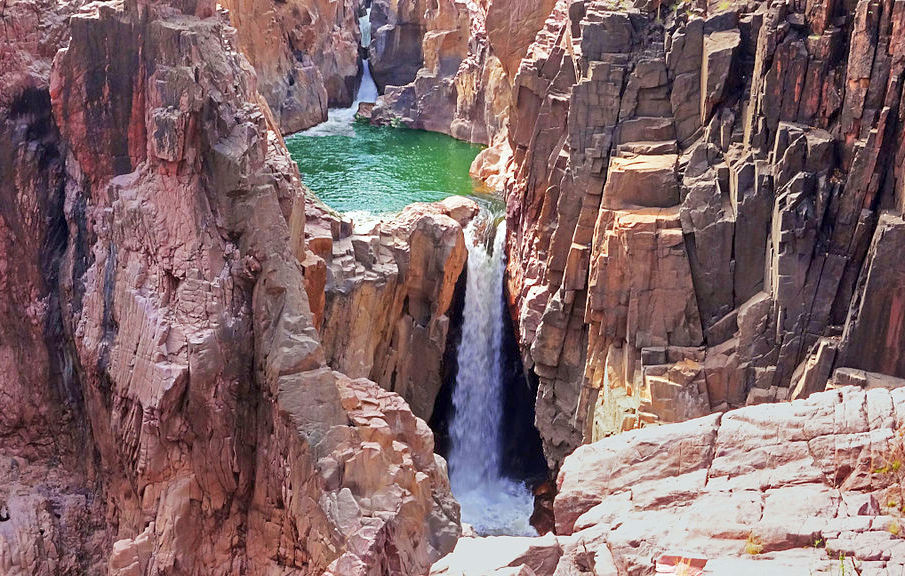
- Eastern Group of Temples that include among others, the Javari Temple, Vamana Temple, Adinatha Jain Temple, Parshvanatha Temple
- Southern Group of Temples that include Duladeo Temple and Chaturbhuj Temple
- Western Group of Temples including Lakshmana Temple, Kandariya Mahadev Temple, Jagadamba Temple
- Archaeological Museum Khajuraho
- Raneh Waterfalls located about 20 kilometers from Khajuraho
- Ajaigarh Fort at a distance of about 60 kilometers from Khajuraho
- Kalinjar Fort which is about 100 kilometers from Khajuraho
Best Time To Visit The Khajuraho Jain Temples
Khajuraho weather is pleasant during the winter months and that is the best time to visit, not only the Jain group of temples in Khajuraho but all other temples and attractions in the vicinity. Khajuraho temperature soars during the summers and visiting the monuments can be tiring as the sun goes up. The best time to visit Khajuraho is between the months of October to February when the weather is quite pleasant.
How To Get To Khajuraho in Madhya Pradesh, India
- The Jain temples of Khajuraho are part of the Eastern Group of Temples in Khajuraho
- Khajuraho is located in the central Indian state of Madhya Pradesh
- Khajuraho is at a distance of 645 kilometres from Delhi and is connected by air, rail, and road
- Bhopal to Khajuraho distance is about 375 kilometres
- Orchha to Khajuraho distance is about 171 kilometres
- The Khajuraho Airport is about 5 kilometres from the Khajuraho monuments and has flights from and to Varanasi and Delhi
Are you enamoured by the beauty of the Khajuraho temples and want to visit them? Khajuraho has an airport so you can fly to Khajuraho from any of the other Indian airports. If you are planning a trip to Khajuraho, you can book a cheap flight through TripAdvisor or Agoda or CheapAir or Cleartrip or Makemytrip or Priceline right here. If you want to do a road trip, you can travel by road to Khajuraho from Bhopal by self-drive car or cab or bus.
Where To Stay In Khajuraho, MP, India
Khajuraho, being a UNESCO World Heritage Site and a major tourist attraction in India, one can find many options to have a pleasant stay while exploring the monuments. We stayed at the Lalit Temple View Khajuraho, a luxury 5-star hotel with all amenities including swimming pool, spa, and conference rooms. The temple also offers a view of the Western Group of Temples.
If you want to enjoy a stay in a resort a little away from Khajuraho on a pristine island in the midst of enchanting landscapes, then the Kutini Island Resort run by Madhya Pradesh Tourism is just for you.
If you are looking to book these or any other hotels in Khajuraho, you can do that right here. You can book Khajuraho hotels through TripAdvisor or Cleartrip or Agoda or Makemytrip or Priceline and save a lot by getting the best savings on booking your stay.
| Click to book the best hotels in Khajuraho, MP or best hotels in Madhya Pradesh |
|---|
Where to eat in Khajuraho
While in Khajuraho, one can get a variety of cuisines. Check out some of the best places to eat in Khajuraho.
Planning a trip in Madhya Pradesh – Best things to see and do in Madhya Pradesh, India
Once you land in Bhopal, Madhya Pradesh you can book package tours that can take you to Sanchi, Bhimbetka, Udaygiri caves, Bhojpur, Pachmarhi, Khajuraho, Maheshwar, Kanha National Park, etc. You could also do a one day Bhopal city tour or even choose to do a heritage walk in Bhopal. Plan your trip and book online places to visit in Madhya Pradesh.
| Click here to know more and book Best Attractions in Bhopal & MP |
|---|
We do hope you liked our post about the Jain Temples of Khajuraho. Do let us know your thoughts through the comments section. Keep coming back to our blog for more and more interesting articles about the rich and varied heritage of India.
We were hosted by Times Passion Trails and Madhya Pradesh Tourism. However, the views and opinions expressed here are our own.
We recommend you to also read the following posts on Madhya Pradesh:
Sanchi Stupa – A Timeline Of Buddhism In India
Places To Visit In Chanderi – Madhya Pradesh’s Hidden Gem
Pench National Park – Tiger Reserve in Madhya Pradesh, India
Places To Visit In Pachmarhi, Madhya Pradesh, India
Tajul Masajid – Bhopal’s Crowning Glory
Kutni Island Resort – Khajuraho’s Pristine Getaway
Do You Love Traveling?
Do you want to know how to travel the world? We have put together a very useful travel resources page with best travel tips. Go check it out now.
Thanks for visiting our site Voyager – imvoyager.com and taking the time to read this post!
If you wish to collaborate/work with us then reach us at [email protected]
We’d love if you’d comment by sharing your thoughts on this post and share this post on social media and with your friends.
[shareaholic app=”share_buttons” id=”27413782″]
Follow our journey on our social media channels:
Facebook Twitter Instagram Pinterest YouTube
60+ Million Users Trust TripAdvisor With Their Travel Plans. Shouldn’t You?

 The Jain temples of Khajuraho, part of the Eastern Group of temples are wonderful representations of the grandeur and aesthetics of the Khajuraho temples.
The Jain temples of Khajuraho, part of the Eastern Group of temples are wonderful representations of the grandeur and aesthetics of the Khajuraho temples.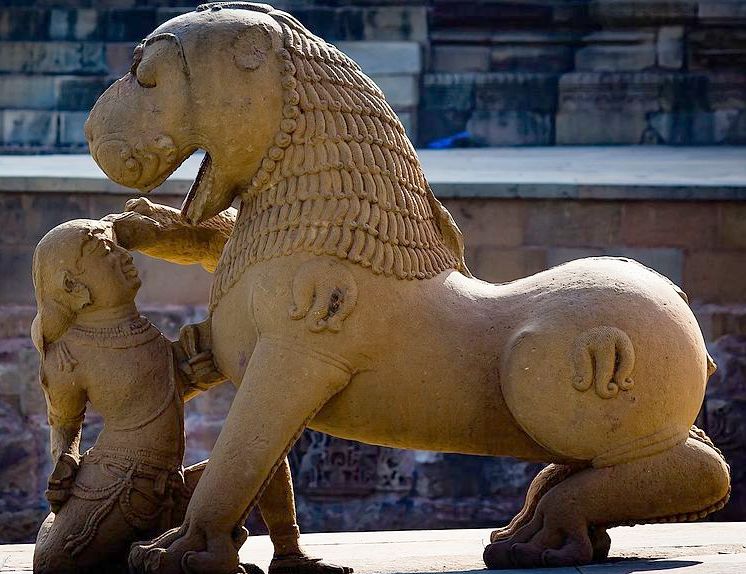
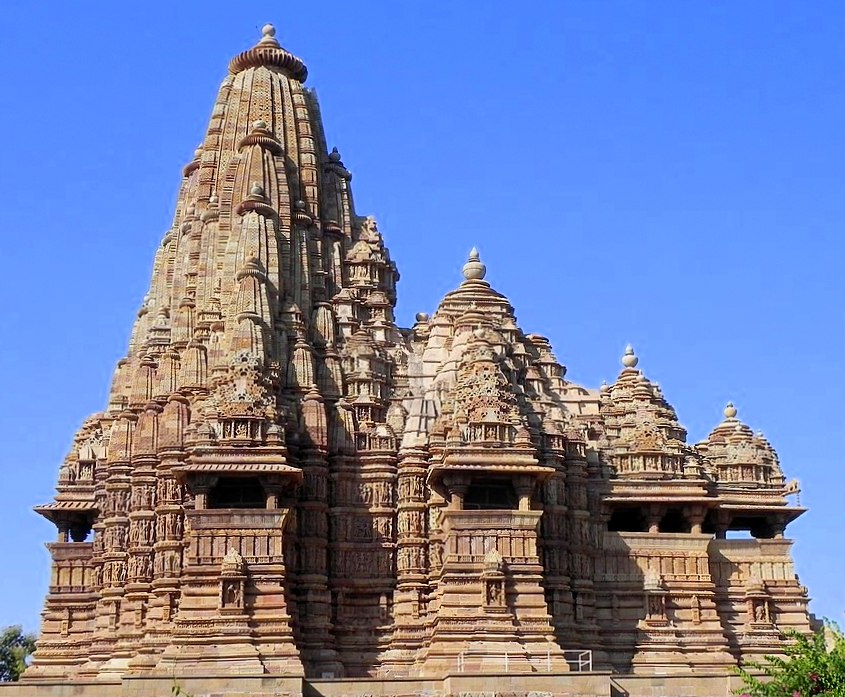
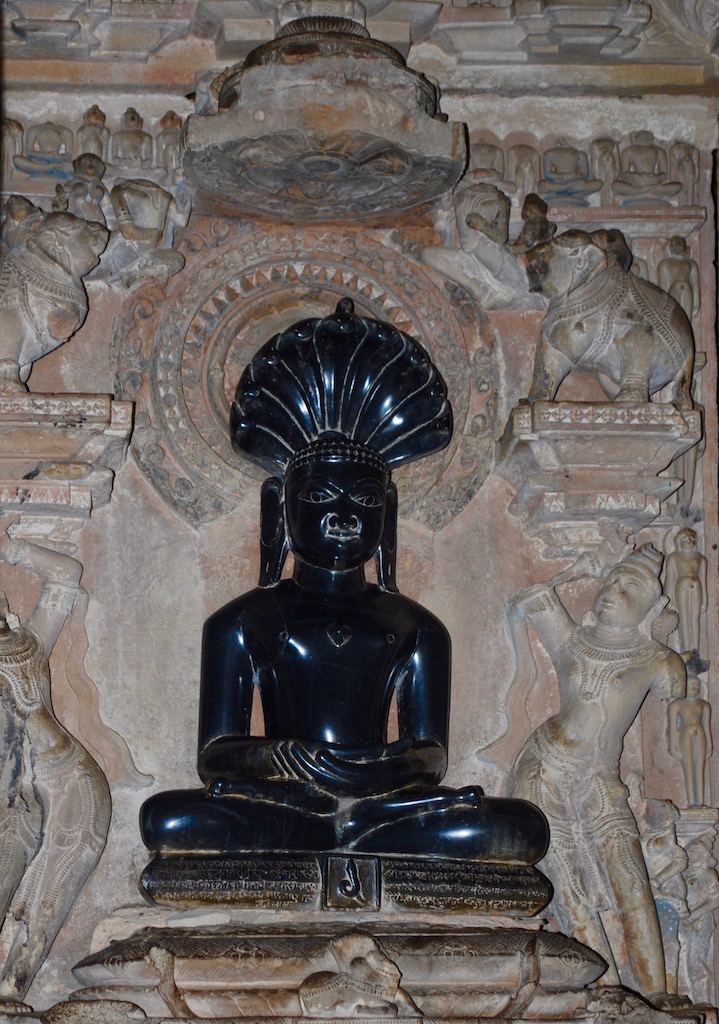
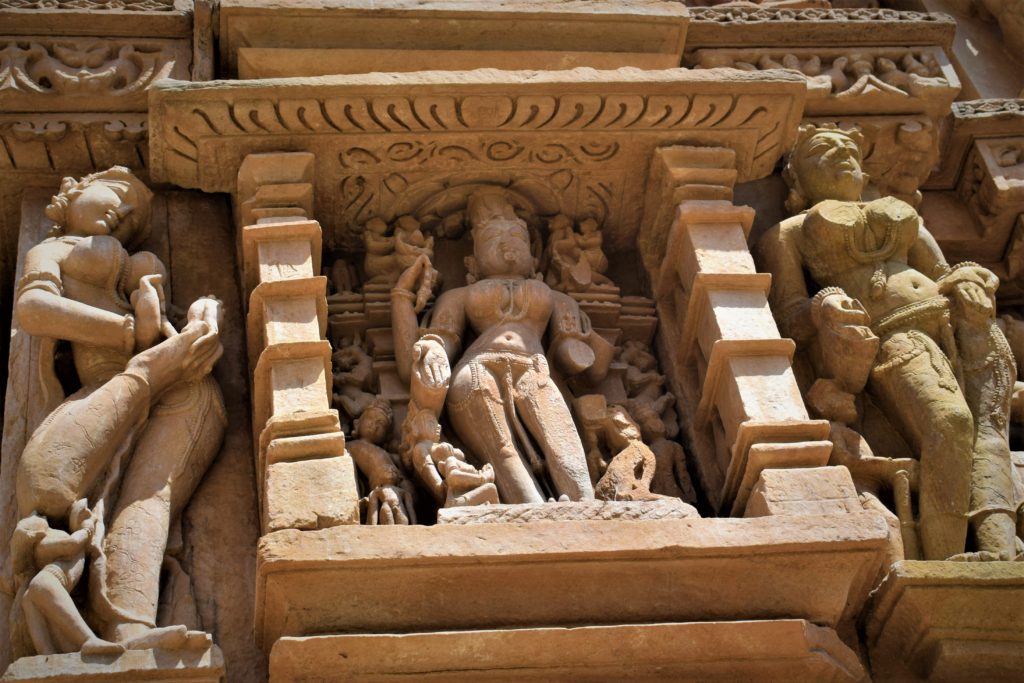

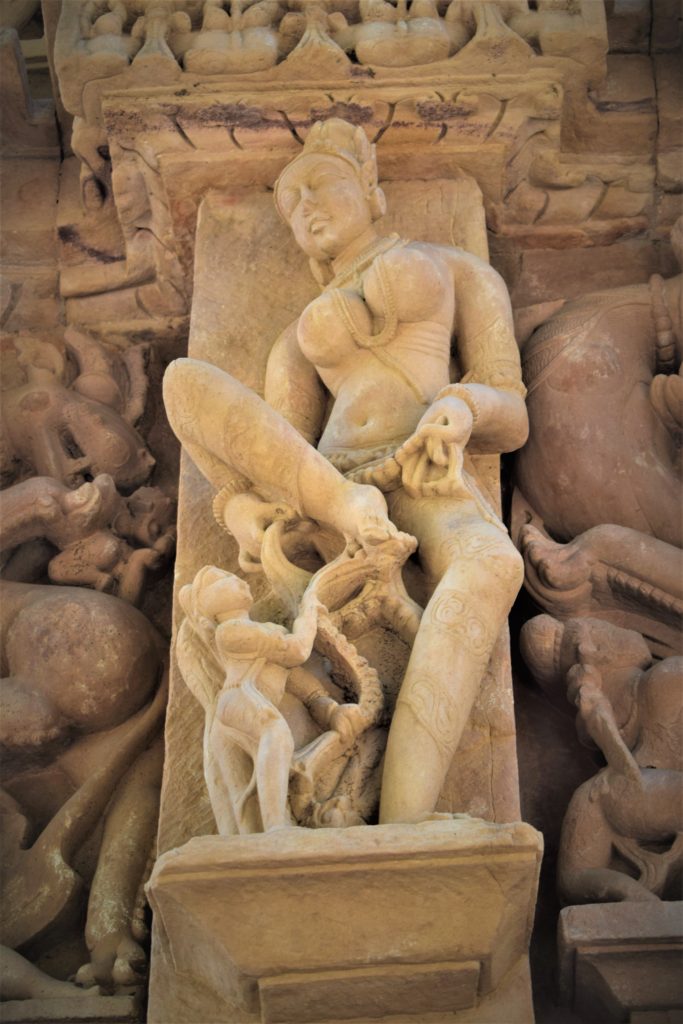

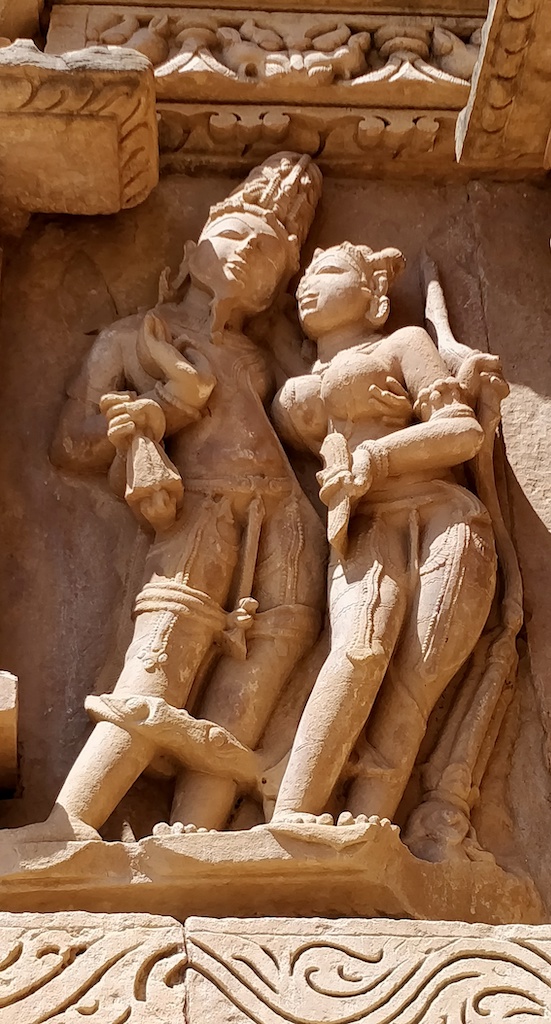
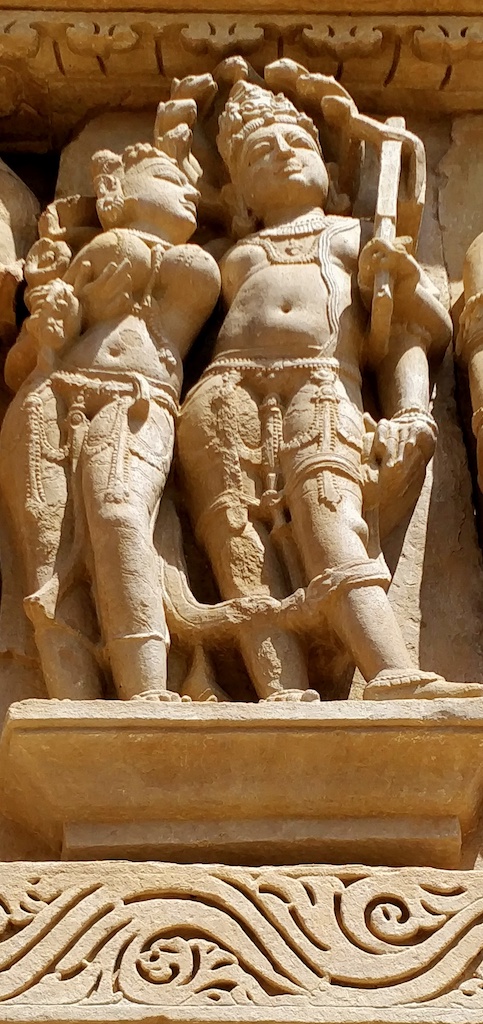





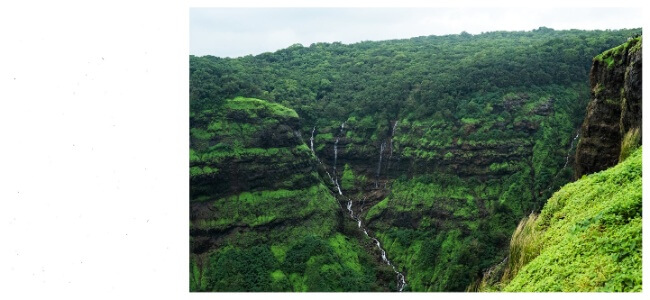


We finished our Khajuraho temple visit with the Jain temples. Looking at the cemented structure we were skeptical at first but when we went inside and saw the Parsavnath temple in its full glory we realised, these are as good as the Hindu temples. We revisited this place through your blog and pictures.
My God this is such an indepth & detailed Blog post. Had a great time knowing about these temples.. i had no idea of so much .. keen to visit these
I love the atmosphere and sculpture works and traditions of Jain Temples. Haven’t been to Khajrao, but your blog has instilled in me an urge to visit this beautiful place. Lovely captures too.
Wow I loved yr photography skills and the way you have described all the ancient beautiful places.
Temples at Khajurao are really beautiful and a good instance of our history. The information shared is so vast.
Have heard a lot about Khajurao before and with your detailed post, it felt as if am there.
Excellent write up.
wow such a well researched article I have seen after a long time. You did an amazing job in compiling this list. Kudos.
I love your blogs because of the depth and research you put into it. You cover everything related to the place. If I ever go to this place I am surely visiting the Jain temples.
your photographs and write up truly do justice to the grandeur of this place. I have been here once, and the sculptures are just fascinating! what talent and craftsmanship!!!
The place you stayed is quite something! I wish we had known of this place and would have stayed here too — looks inviting and very comfortable.
This is something worth a read. Khajuraho temples is one of the most ancient architectures and most visited place. I read about the temples and found it pretty interesting. Bookmarking for my visit.
Khajuraho temples are famous and every traveler and photographer dreams to go there. Your post covers every detail about this place. Amazing pictures and post.
I wonder how they did such intricate work in those ancient times. Looks so beautifu. I have to visit MP really soon. Amazing clicks.
What a beautiful detailed beautiful blog post covering everthing one could ask for.The way you have described the sculptors is simply amazing
Wow this temple has great heritage value. I love visiting such places with long history.❤️ Plus the beauty of this place is unbeatable.
I really want to visit all these temples, now that you’ve shared this wonderful post with exciting details and pictures. Thanks for the elaborate explanation, as always.
Another informative post from you. I am very keen to visit Khajuraho. Your post will be a great help for me to plan a trip there.
So many things to explore in MP about the khajuraho temples. I’ve never been here but love to explore this heritage site
I have stayed in MP when I was a kid and I think we have visited few temples there. I would love to go again there.
Jain temples have their own way of architecture and rich history. Thanks for sharing about this place … Didn’t know.
Beautiful pictures with well written post. This is check list of travellers like me, thanks for the blog.